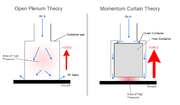
Momentum curtain
Encyclopedia
Discovered by British engineer Christopher Cockerell
, the momentum curtain is a unique and efficient way to reduce friction
between a vehicle and its surface of travel, be it water or land, by levitating the vehicle above this surface via a cushion of air. It is this principle of levitation upon which a hovercraft
is based, and Christopher Cockerell set about applying his momentum curtain theory to hovercraft to increase their abilities in overcoming friction
in travel.
Levitating a vehicle above the ground/water to reduce its drag was not a new concept. John Thornycroft
, in 1877, discovered that trapping air beneath a ship's hull, or pumping air beneath it with bellows
, decreased the effects of friction upon the hull thereby increasing the ship's top attainable speeds. However, technology at the time was insufficient for Thornycroft's ideas to be developed further.
 Cockerell used the idea of pumped air under a hull (this then becoming a plenum
Cockerell used the idea of pumped air under a hull (this then becoming a plenum
, i.e. the opposite of a vacuum
) and improved upon it further. Simply pumping air between a hull and the ground wasted a lot of energy in terms of leakage of air around the edges of the hull. Cockerell discovered that by means of generating a wall (curtain) of high-speed downward-directed air around the edges of a hull, that less air leaked out from the sides (due to the momentum of the high-speed air molecules), and thus a greater pressure could be attained beneath the hull. So, with the same input power, a greater amount of lift could be developed, and the hull could be lifted higher above the surface, reducing friction and increasing clearance. This theory was tried, tested and developed throughout the 1950s and 1960s until it was finally realised in full-scale in the SR-N1
hovercraft.
Christopher Cockerell
Sir Christopher Sydney Cockerell CBE FRS was an English engineer, inventor of the hovercraft.-Life:Cockerell was born in Cambridge, where his father, Sir Sydney Cockerell, was curator of the Fitzwilliam Museum, having previously been the secretary of William Morris. Christopher Cockerell was...
, the momentum curtain is a unique and efficient way to reduce friction
Friction
Friction is the force resisting the relative motion of solid surfaces, fluid layers, and/or material elements sliding against each other. There are several types of friction:...
between a vehicle and its surface of travel, be it water or land, by levitating the vehicle above this surface via a cushion of air. It is this principle of levitation upon which a hovercraft
Hovercraft
A hovercraft is a craft capable of traveling over surfaces while supported by a cushion of slow moving, high-pressure air which is ejected against the surface below and contained within a "skirt." Although supported by air, a hovercraft is not considered an aircraft.Hovercraft are used throughout...
is based, and Christopher Cockerell set about applying his momentum curtain theory to hovercraft to increase their abilities in overcoming friction
Friction
Friction is the force resisting the relative motion of solid surfaces, fluid layers, and/or material elements sliding against each other. There are several types of friction:...
in travel.
Levitating a vehicle above the ground/water to reduce its drag was not a new concept. John Thornycroft
John Isaac Thornycroft
Sir John Isaac Thornycroft was a British shipbuilder, the founder of the Thornycroft shipbuilding company and member of the Thornycroft family.-Biography:He was born in 1843 to Mary Francis and Thomas Thornycroft....
, in 1877, discovered that trapping air beneath a ship's hull, or pumping air beneath it with bellows
Bellows
A bellows is a device for delivering pressurized air in a controlled quantity to a controlled location.Basically, a bellows is a deformable container which has an outlet nozzle. When the volume of the bellows is decreased, the air escapes through the outlet...
, decreased the effects of friction upon the hull thereby increasing the ship's top attainable speeds. However, technology at the time was insufficient for Thornycroft's ideas to be developed further.

Plenum chamber
A plenum chamber is a pressurised housing containing a gas or fluid at positive pressure . One function of the plenum can be to equalise pressure for more even distribution, because of irregular supply or demand...
, i.e. the opposite of a vacuum
Vacuum
In everyday usage, vacuum is a volume of space that is essentially empty of matter, such that its gaseous pressure is much less than atmospheric pressure. The word comes from the Latin term for "empty". A perfect vacuum would be one with no particles in it at all, which is impossible to achieve in...
) and improved upon it further. Simply pumping air between a hull and the ground wasted a lot of energy in terms of leakage of air around the edges of the hull. Cockerell discovered that by means of generating a wall (curtain) of high-speed downward-directed air around the edges of a hull, that less air leaked out from the sides (due to the momentum of the high-speed air molecules), and thus a greater pressure could be attained beneath the hull. So, with the same input power, a greater amount of lift could be developed, and the hull could be lifted higher above the surface, reducing friction and increasing clearance. This theory was tried, tested and developed throughout the 1950s and 1960s until it was finally realised in full-scale in the SR-N1
SR-N1
The Saunders-Roe SR.N1 was the first practical hovercraft.-Design:It was designed by Christopher Cockerell and built by Saunders-Roe on the Isle of Wight under the auspices of the National Research and Development Corporation...
hovercraft.

